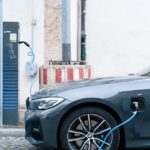 What do Houston, Los Angeles, New York, and Chicago have in common? Dense populations, high traffic volumes, and air quality that fail to meet ozone standards set by the U.S. Environmental Protection Agency. These factors made each city a prime candidate for a University of Houston study on the impact of vehicle electrification on air quality and public health.
What do Houston, Los Angeles, New York, and Chicago have in common? Dense populations, high traffic volumes, and air quality that fail to meet ozone standards set by the U.S. Environmental Protection Agency. These factors made each city a prime candidate for a University of Houston study on the impact of vehicle electrification on air quality and public health.
The study examined changes in air pollution, specifically PM2.5 and ozone levels, under different electrification scenarios in these major U.S. cities.
Health benefits
The findings were significant: switching to electric vehicles could prevent 157 premature deaths each month in Houston. New York and Chicago could see even greater benefits, with 796 and 328 premature deaths avoided per month, respectively. In Los Angeles, a 29% EV share for light-duty vehicles could save 104 lives each month, but full electrification might increase mortality due to higher PM2.5 and ozone levels.
“Our findings indicate that vehicle electrification generally helps reduce greenhouse gas emissions, improve air quality, and lower mortality rates associated with toxic air pollutants,” the researchers explain.
However, due to Los Angeles’ unique atmospheric chemistry and geography, full electrification might lead to increased secondary aerosols, potentially raising mortality rates. This underscores the need for region-specific environmental regulations.
Regional differences
In the full electrification scenario (FullE), PM2.5 levels—tiny particles harmful to lungs—dropped by up to 2.29 µg/m³ in many areas. Surprisingly, parts of eastern Los Angeles saw PM2.5 levels rise by up to 0.67 µg/m³ due to an increase in secondary organic aerosols caused by changes in nitrogen oxides, volatile organic compounds dynamics, and hydroxyl radical concentrations.
Los Angeles’ unique weather and geography, including a mountain range to the east, can trap air pollutants, leading to higher pollution concentrations in downwind areas.
The study also found significant reductions in nitrogen oxides and maximum daily average 8-hour ozone levels in the FullE scenario, with drops to 14.00-32.34 parts per billion and 2.58-9.58 ppb, respectively. However, some areas saw increases in ozone, highlighting the complexity of air quality management.
Economically, the FullE scenario promises significant health-related savings, ranging from $51 million to $249 million per day for New York, Chicago, and Houston. Conversely, Los Angeles could face economic losses up to $18 million per day.
Different sources
“The four largest U.S. cities have distinct sources of air pollutants and greenhouse gases,” the authors explain. “Each city requires unique regulations or strategies, including different scenarios for the adoption of electric vehicles, to effectively reduce pollutant concentrations.”
The overall impact on air quality is complex. Estimating future scenarios related to electric vehicles and changes in other sources—such as industry, residential areas, biogenic emissions, and oceanic emissions—adds to this complexity. However, the researchers see great potential in the push for transportation electrification.
“In the future, we anticipate more electric vehicles on the road, which will help reduce emissions of air pollutants and greenhouse gases from vehicles. By considering the expected percentage of electric vehicles, we can estimate the impact on air pollutant and greenhouse gas concentrations, which ultimately affect human health,” they explain.
Unique approaches required
This study shows that there is no one-size-fits-all solution. Effective and nuanced air quality management is crucial for a cleaner, healthier world.
“The findings of this study will help policymakers tailor their regulations to the specific characteristics of different regions to enhance quality of life,” the authors conclude.
As America and the world move towards a greener future with electric vehicles, these findings highlight the need for a balanced and thoughtful approach to ensure both environmental and public health benefits are fully realized.